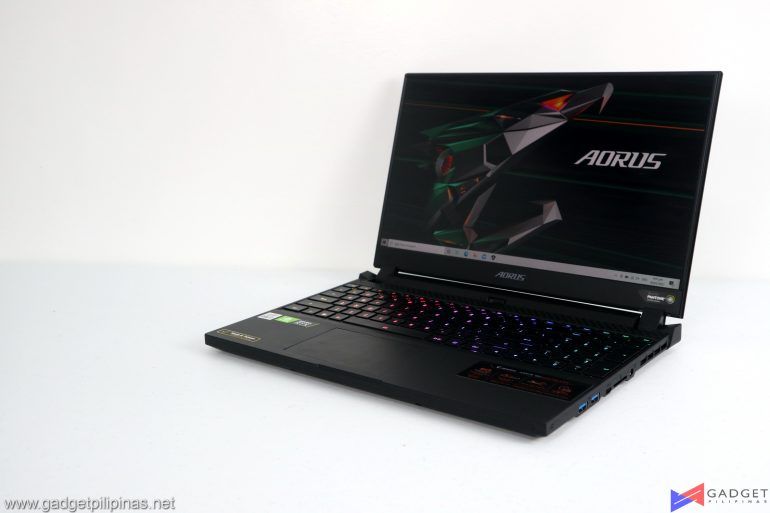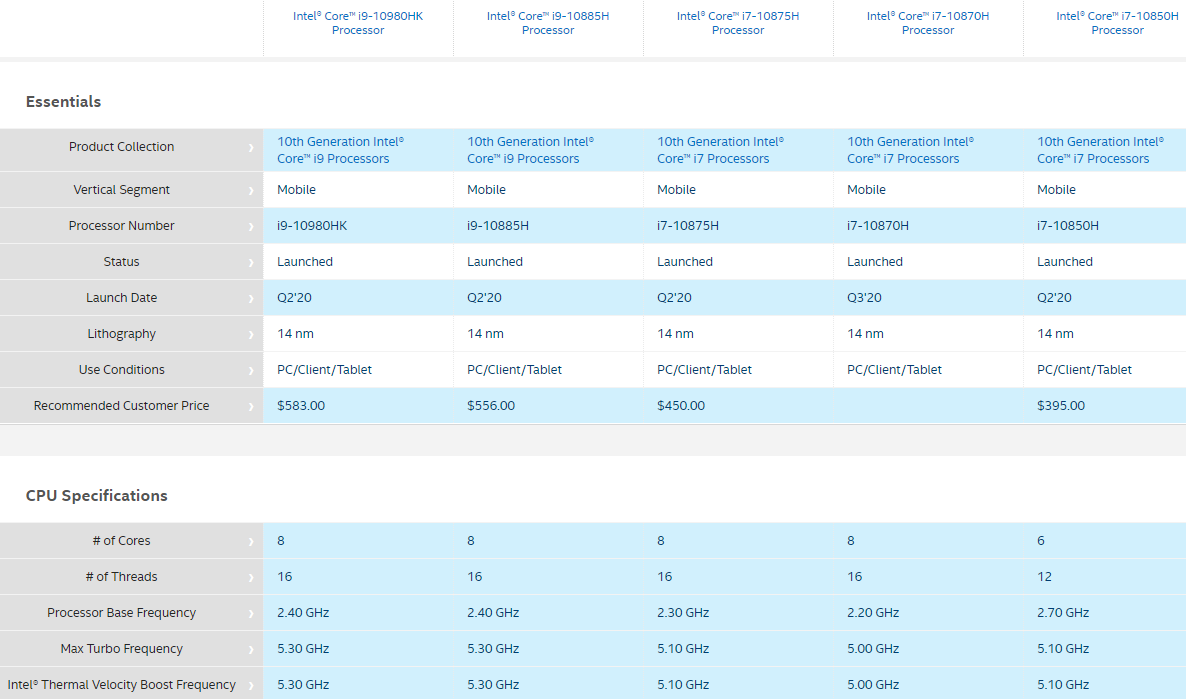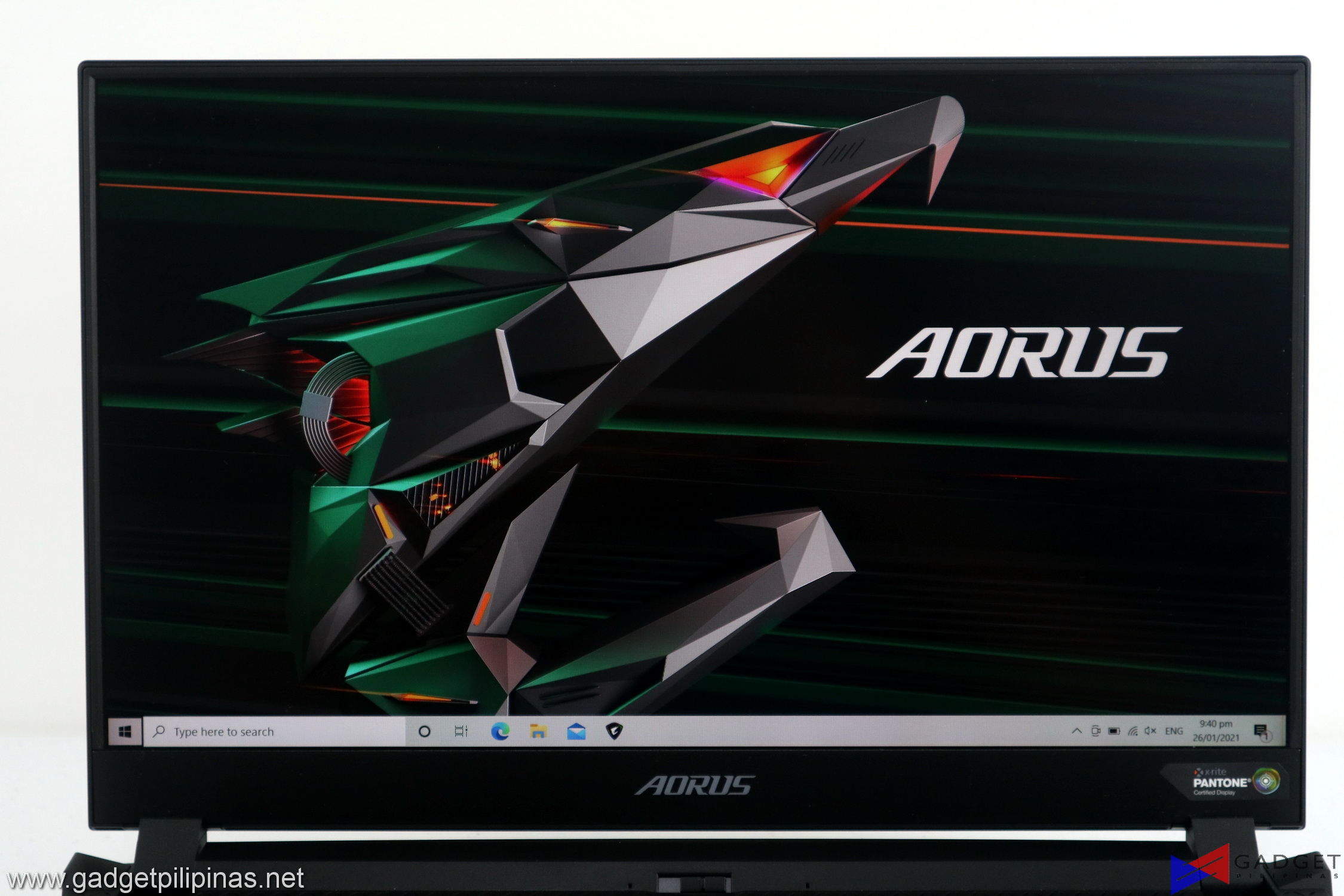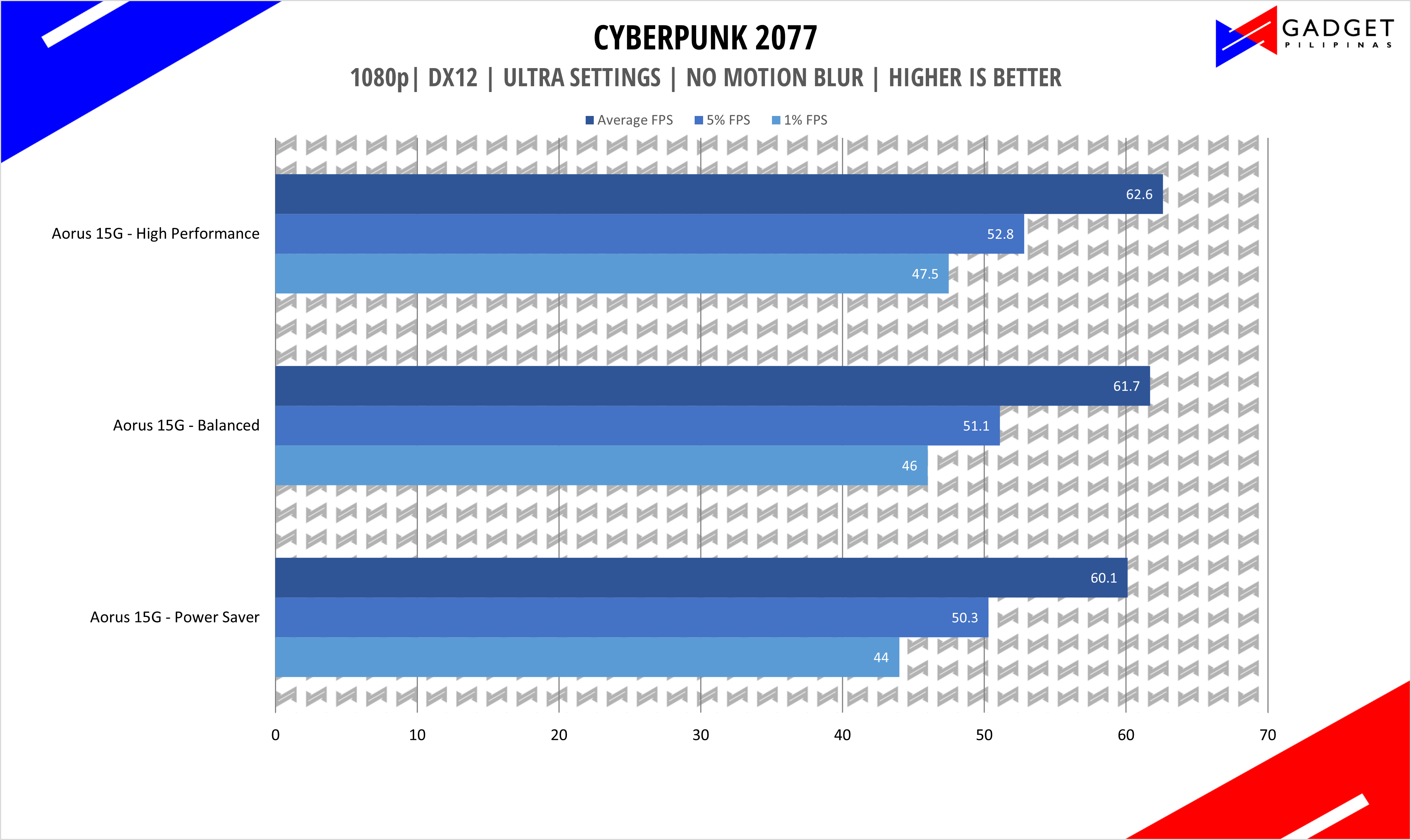Introduction
January 2021 started out strong as Nvidia announced mobile versions of their successful RTX 30 series graphics cards alongside the debut of the desktop RTX 3060. The first RTX 30 series powered gaming laptop to arrive in the Philippines is the Aorus 15G XC, beating locally established brands such as Asus, Lenovo, and Acer in terms of availability. The star underneath the well-crafted Aorus 15G XC is the Nvidia GeForce RTX 3070 paired with an Intel Core i7-10870H processor.
The Intel Core i7-10870H on the Aorus 15G is an interesting choice to pair up with the RTX 3070. The cheaper $417 RCP(Recommended Customer Price) of the i7-10870H seems reasonable compared to getting the Intel Core i7-10875H at $450 RCP as the former is only slower in base and boost clock by 100Mhz. The choice of getting a slightly cheaper processor with the 100Mhz tradeoff allows the Aorus 15G XC to be priced slightly lower.
| GPU | RTX 3080 Laptop GPU | RTX 3070 Laptop GPU | RTX 3060 Laptop GPU | RTX 3080 Desktop | RTX 3070 Desktop | RTX 3060 Desktop |
| NVIDIA CUDA Cores | 6144 | 5120 | 3840 | 8704 | 5888 | 8704 |
| Boost Clock(Mhz) | 1245-1710 | 1290-1620 | 1283-1703 | 1440-1710 | 1500-1730 | 1320-1780 |
| GPU Power(Watts) | 80-150+ | 80-125 | 60-115 | 320 | 220 | 170 |
| Memory Configuration | 16GB or 8GB GDDR6 | 8GB GDDR6 | 6GB GDDR6 | 10GB GDDR6X | 8GB GDDR6 | 12GB GDDR6 |
| Memory Interface Width | 256-bit | 256-bit | 192-bit | 320-bit | 256-bit | 192-bit |
| RT Cores | 2nd Gen | 2nd Gen | 2nd Gen | 2nd Gen | 2nd Gen | 2nd Gen |
| Tensor Cores | 3rd Gen | 3rd Gen | 3rd Gen | 3rd Gen | 3rd Gen | 3rd Gen |
| PCIE Gen 4 | Yes | Yes | Yes | Yes | Yes | Yes |
| HDMI 2.1 | Yes | Yes | Yes | Yes | Yes | Yes |
| Displayport 1.4a | Yes | Yes | Yes | Yes | Yes | Yes |
The RTX 3070 Laptop GPU has 14% fewer CUDA cores than its desktop counterpart but only consumes up to 43 to 63% less wattage depending on the configuration. The base clock speed difference is higher compared to the boost clock difference at 14% and 6% respectively. Based on the table above, it seems like the RTX 3070 Laptop GPU has the closest spec to its GPU counterpart compared to the RTX 3080s and RTX 3060s.
Aorus 15G Specs
| Aorus 17G XC | Aorus 17G YC | Aorus 15G YC | |
| GPU | Nvidia GeForce RTX 3070 GDDR6 8GB | Nvidia GeForce RTX 3080 GDDR6 8GB | Nvidia GeForce RTX 3080 GDDR6 8GB |
| CPU | Intel Core i7 10870H | Intel Core i7 10870H | Intel Core i7 10870H |
| Display | 17.3″ FHD 300Hz IPS-level Display with NSTC 72% | 17.3″ FHD 300Hz IPS-level Display with NSTC 72% | 15.6″ FHD 240Hz IPS-level Display with NSTC 72% |
| Memory | DDR4 2933Mhz 16GB*2 | DDR4 2933Mhz 16GB*2 | DDR4 2933Mhz 16GB*2 |
| Storage | 512GB PCIe M.2 SSD | 1TB PCIe M.2 SSD | 1TB PCIe M.2 SSD |
| Keyboard | OMRON True Mechanical Keyboard | OMRON True Mechanical Keyboard | Per Key RGB Keyboard |
| OS | Windows 10 | Windows 10 | Windows 10 |
| Cooling | WINDFORCE Infinity Cooling System | WINDFORCE Infinity Cooling System | WINDFORCE Infinity Cooling System |
| Microsoft Azure AI | Microsoft Azure AI | Microsoft Azure AI | |
| Warranty | 2Year Global Warranty | 2Year Global Warranty | 2Year Global Warranty |
| Cash Price | Php 119,995 | Php 129,995 | Php 129,995 |
The Aorus 15G is under the AORUS Pro gaming series alongside the Aorus 17G and Aorus 15P. The Aorus Pro gaming series is codesigned with G2 Esports as part of their “performance above all” mantra. The Aorus 15G sits between the 17G gaming flagship and the performance-oriented Aorus 15P. Gigabyte Aorus positions the 15G in its lineup as the laptop with the best portability without sacrificing performance.
Aorus 15G Unboxing and First Impressions
The retail packaging on the Aorus 15G is pretty standard with only the Aorus logo shown in either the front or the back. Both the left and right sides show the laptop model alongside the Intel-inside logo.
 Unlike other gaming laptop brands, the box only reveals the Aorus 15G XC laptop and its 230w charger. No random accessories, mouse, manual, laptop sleeve, or bag.
Unlike other gaming laptop brands, the box only reveals the Aorus 15G XC laptop and its 230w charger. No random accessories, mouse, manual, laptop sleeve, or bag.
Design-wise the Aorus 15G doesn’t deviate from previous Aorus gaming laptop designs. The top lid is matte black with a back-lit Aorus logo that’s reminiscent of previous Apple MacBooks. The bottom part reveals a large vent cutout that covers almost half of the area.
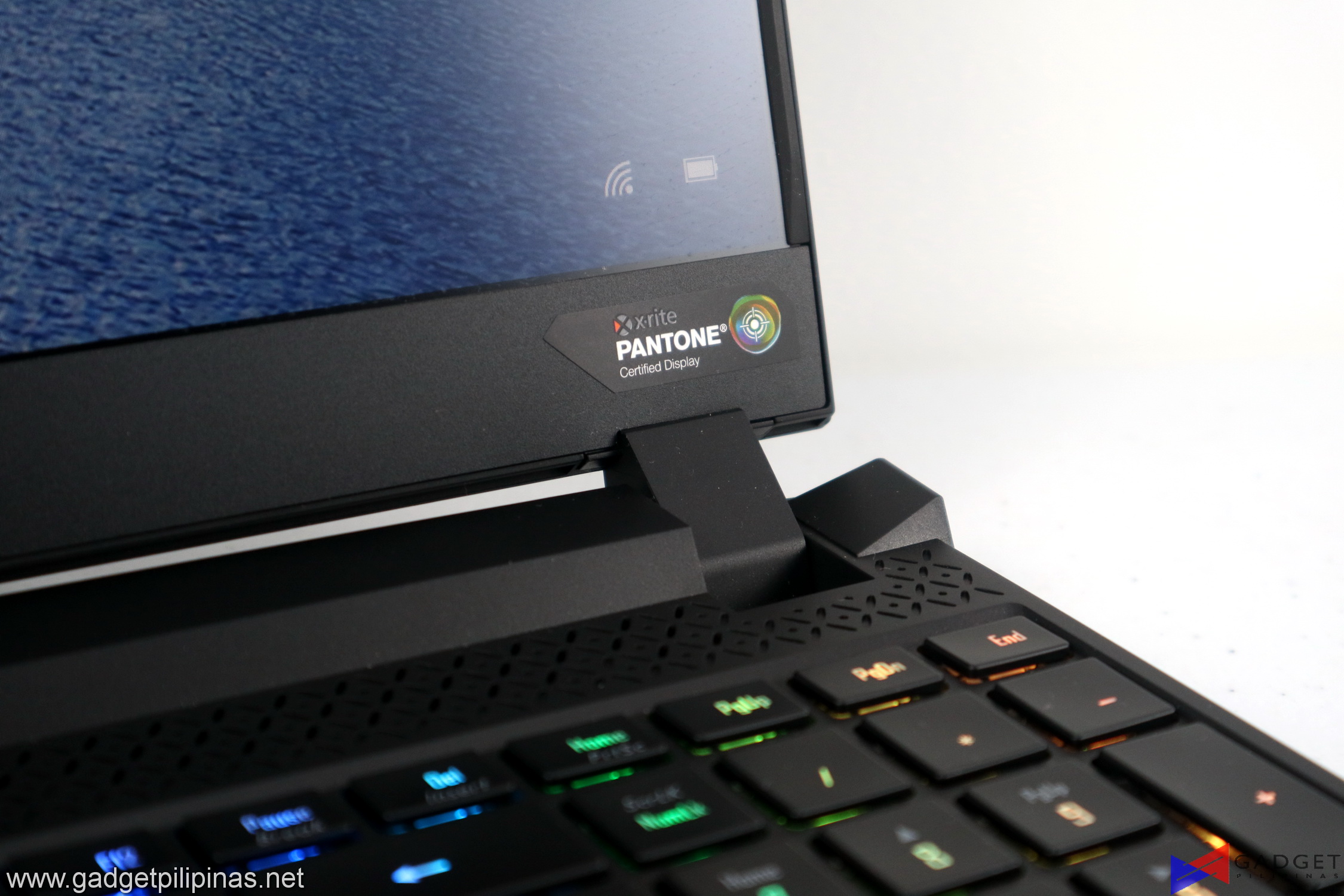 The Aorus 15G uses a traditional hinge design albeit with an edge design.
The Aorus 15G uses a traditional hinge design albeit with an edge design.
Ports selection is pretty standard for a 15.6″ gaming notebook. The left side houses an HDMI 2.1 port, mini Display Port 1.4, USB 3.2 Gen 1 Type-A port, 3.5mm combo jack, and an ethernet port. The other side has two more Type-A ports, a USB 3.2 Gen 1 Type-C port, a UHS-II SD Card reader, and the charging port. The ports are located on the bottom half side as the exhaust vents take up the upper half side of the Aorus 15G.
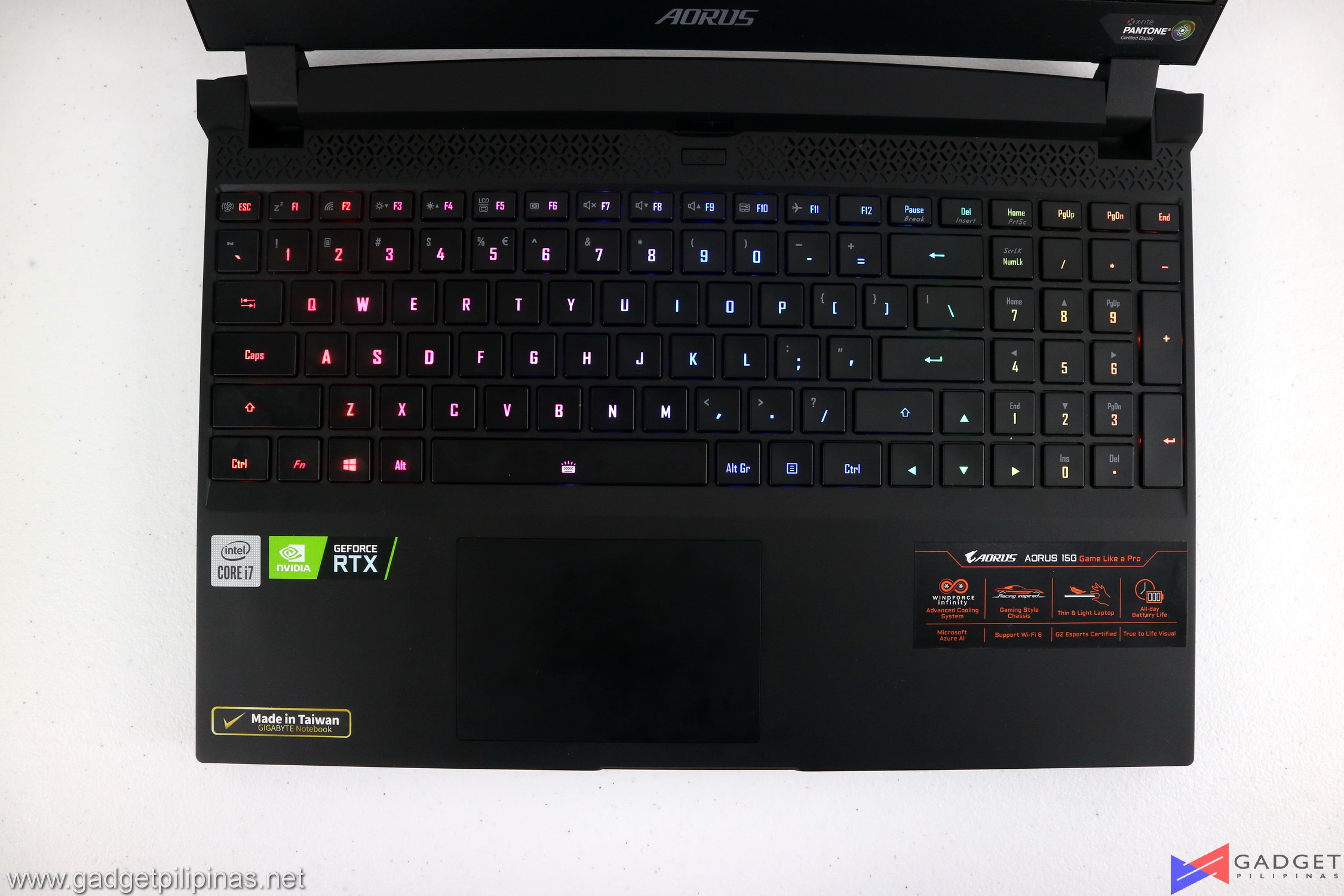 As thin as the gaming laptop looks. Aorus managed to cram in a full-sized keyboard in the Aorus 15G XC. The typing experience on the Aorus 15G’s keyboard is not as delightful as it looks. The 2mm key travel doesn’t feel consistent but rather feels sticky on some keys especially the modifies as it’s more noticeable due to their larger than 1u key size.
As thin as the gaming laptop looks. Aorus managed to cram in a full-sized keyboard in the Aorus 15G XC. The typing experience on the Aorus 15G’s keyboard is not as delightful as it looks. The 2mm key travel doesn’t feel consistent but rather feels sticky on some keys especially the modifies as it’s more noticeable due to their larger than 1u key size.
Typing accurately is a challenge given the keyboard’s actuation but what makes it more challenging is its cramped feeling layout. What I find most infuriating is the awkward right shift size and placement to accommodate the arrow keys particularly the right arrow key. Not only do I miss capitalizing a letter or use a secondary character, but it also causes my cursor to go up which ruins my paragraph thus losing my “momentum” and “focus”.
The trackpad on the other hand uses Windows Precision Touchpad for the most accurate tracking experience available on a Windows device. Button Clicks are consistent throughout the trackpad however there’s a little bit of wiggle that feels like an initial actuation upon clicking.
Display and Camera
The Aorus 15G is equipped with a 15.6-inch 1080p IPS display running at a 240Hz refresh rate. The 240Hz IPS display is factory calibrated and certified by X-Rite Pantone.
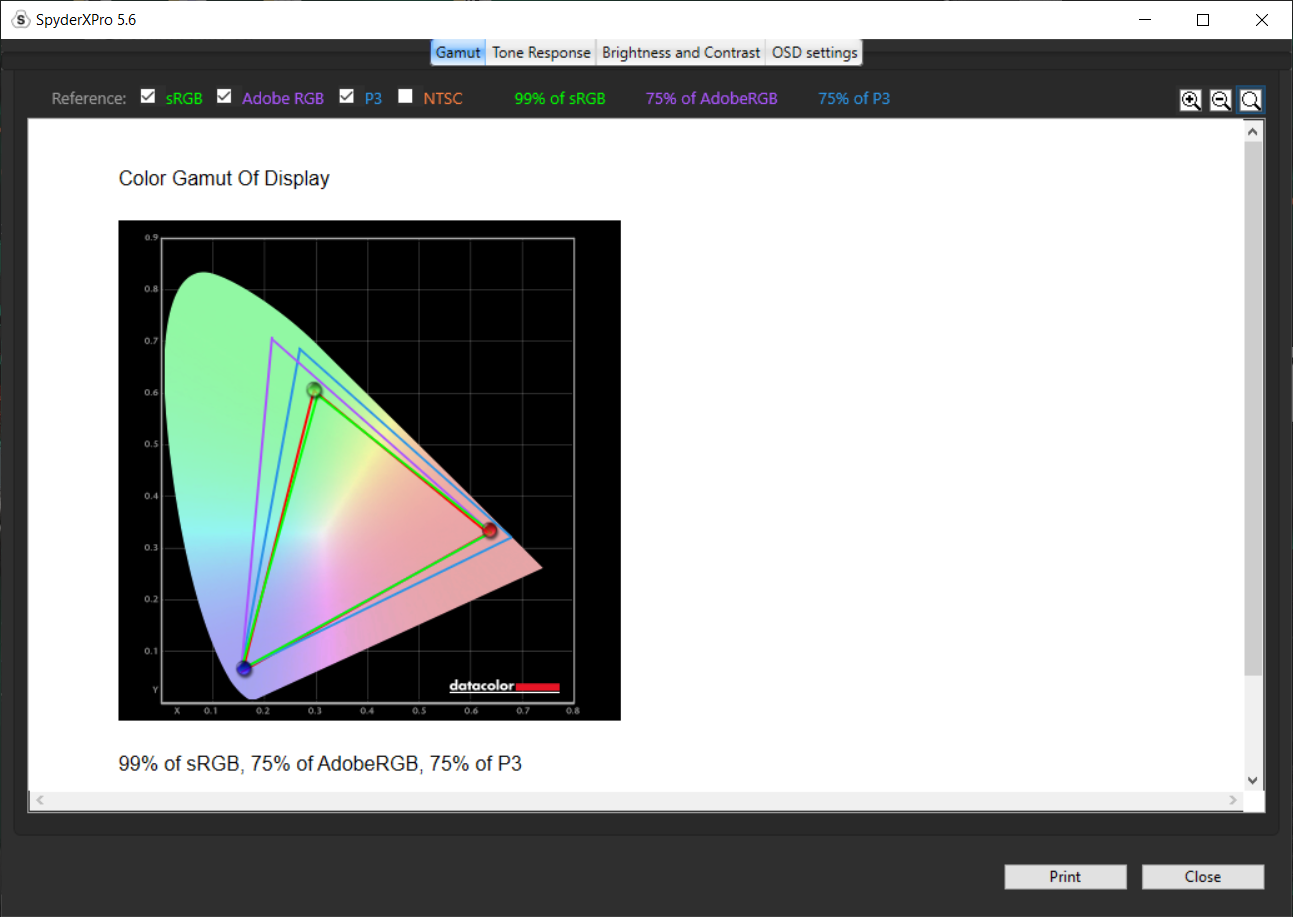 True to Aorus’ marketing spiel and Pantone calibration, the Aorus 15G XC boasts a decent color gamut with 99% sRGB coverage and 75% AdobeRGB. Light Photo and Video editing are feasible for the Aorus 15G.
True to Aorus’ marketing spiel and Pantone calibration, the Aorus 15G XC boasts a decent color gamut with 99% sRGB coverage and 75% AdobeRGB. Light Photo and Video editing are feasible for the Aorus 15G.
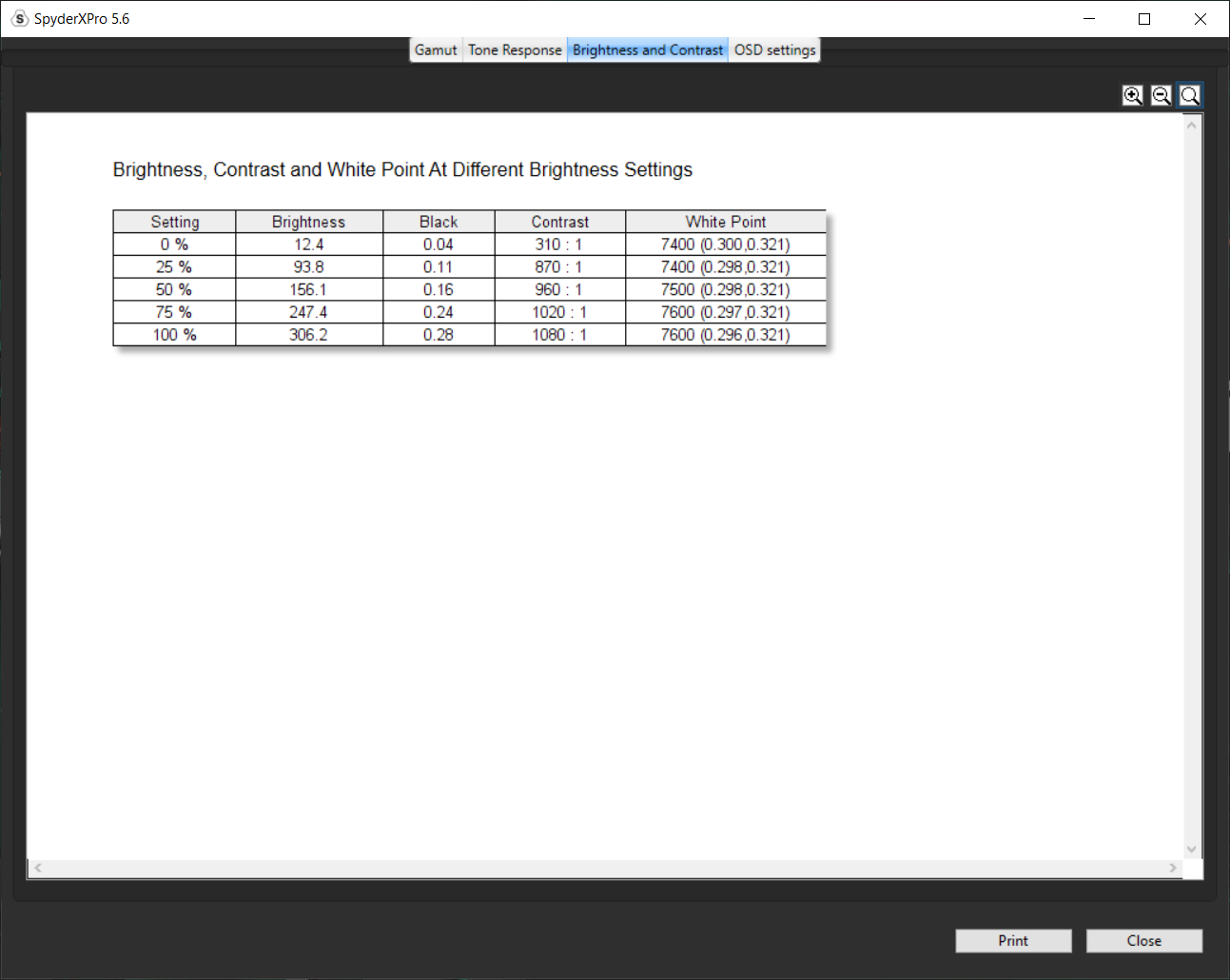 Our SpyderX Pro calibration tool measured a peak brightness of 306 nits which barely passes my standard for laptops – At least you won’t have to worry about working in different lighting environments.
Our SpyderX Pro calibration tool measured a peak brightness of 306 nits which barely passes my standard for laptops – At least you won’t have to worry about working in different lighting environments.
Camera placement seems to be the most displeasing physical aspect of the Aorus 15G XC. The bottom camera is surely a nuisance for video meetings although it’s worth mentioning that at least there’s a privacy slider to physically disable the camera.
The camera quality is slightly better than expected but it’s not enough to make up for its poor placement.
Aorus Control Center and Bloatware
- Aorus 15G Review Control Center 1
- Aorus 15G Review Control Center 1
- Aorus 15G Review Control Center 2
- Aorus 15G Review Control Center 2
- Aorus 15G Review Control Center 3
- Aorus 15G Review Control Center 3
- Aorus 15G Review Control Center 4
- Aorus 15G Review Control Center 4
- Aorus 15G Review Control Center 5
- Aorus 15G Review Control Center 5
- Aorus 15G Review Control Center 6
- Aorus 15G Review Control Center 6
The Aorus Control Center arguably has the best software suite for a gaming laptop. Aorus Control Center has minimal tabs, thus requiring lesser navigation to change system settings such as power modes, display modes, fan profiles, etc. It also serves as an all-in-one driver update utility software.
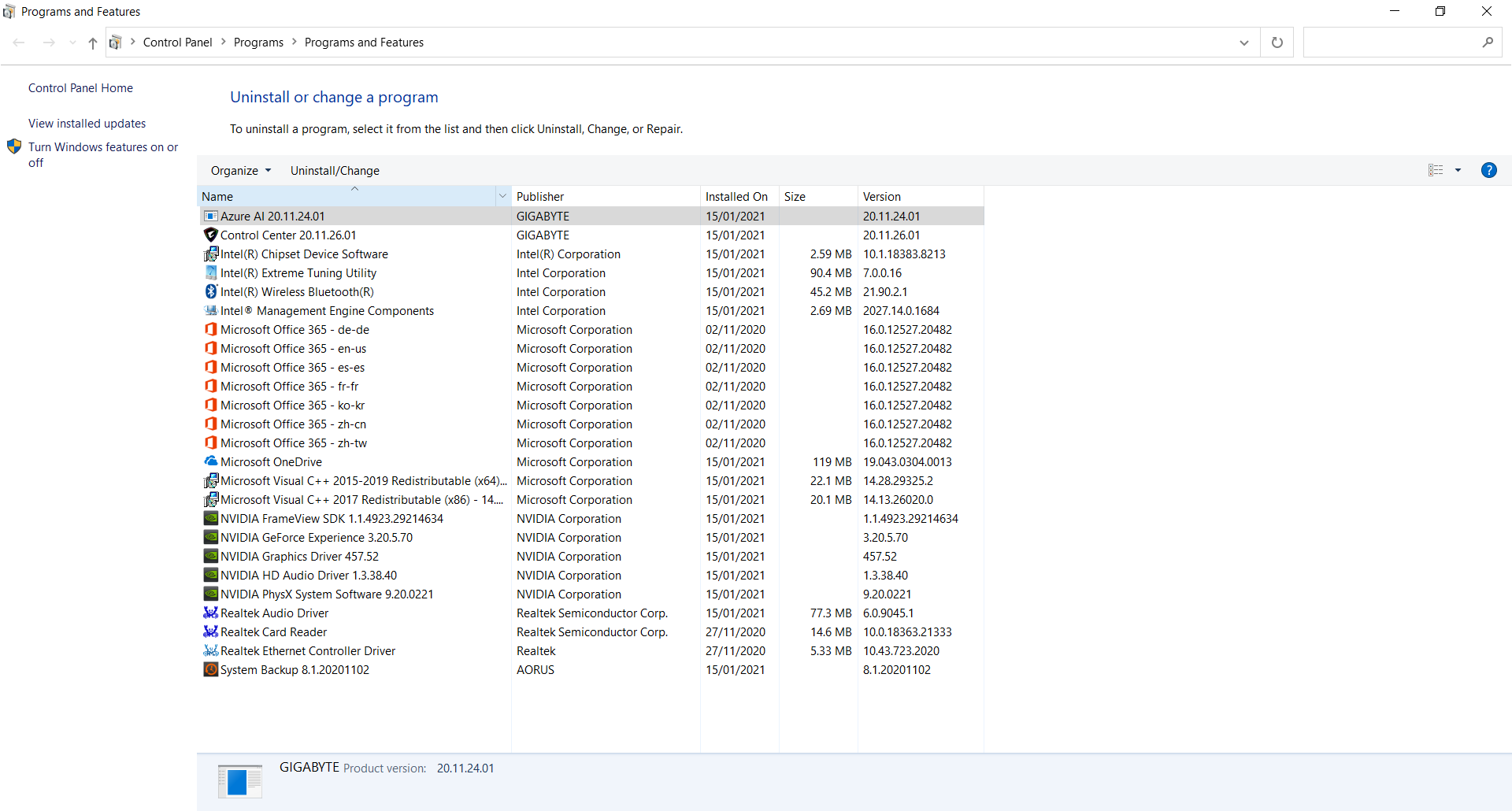 There’s a very minimal amount of bloatware installed on the Aorus 15G XC with only the necessary drivers pre-installed as well as Microsoft Office, and Aorus-specific apps like Azure AI, Control Center and System Backup. Kudos to Aorus for an-almost clean out-of-the-box gaming laptop software, not to mention the omission of an antivirus app like McAfee or Norton.
There’s a very minimal amount of bloatware installed on the Aorus 15G XC with only the necessary drivers pre-installed as well as Microsoft Office, and Aorus-specific apps like Azure AI, Control Center and System Backup. Kudos to Aorus for an-almost clean out-of-the-box gaming laptop software, not to mention the omission of an antivirus app like McAfee or Norton.
Synthetic Benchmarks
We benchmarked the Aorus 15G together with its different power settings found in the Aorus Control Center. The main purpose of benchmarking power profiles will show how aggressive or conservative the manufacturer is in thermal management. These profiles will affect the CPU and GPUs’ boosting behavior in terms of duration and max clock speed which will translate to higher scores and stable framerates.
SuperPI 32M
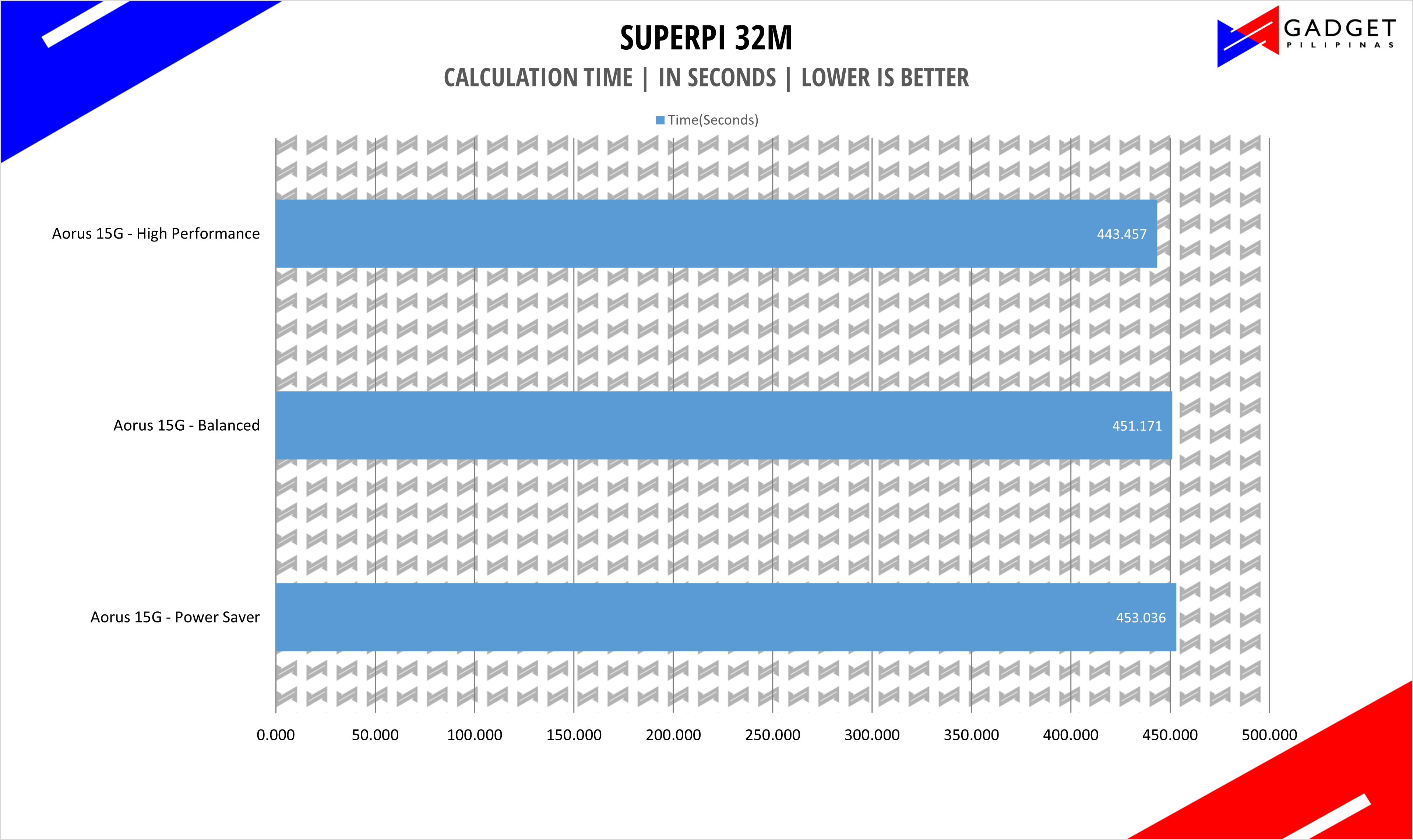 SuperPI is a single-threaded benchmark application that lets the CPU calculate Pi(π) to the nth digit. In this benchmark, we selected the Pi calculation to 32M, the highest available for the app.
SuperPI is a single-threaded benchmark application that lets the CPU calculate Pi(π) to the nth digit. In this benchmark, we selected the Pi calculation to 32M, the highest available for the app.
wPrime 1024M
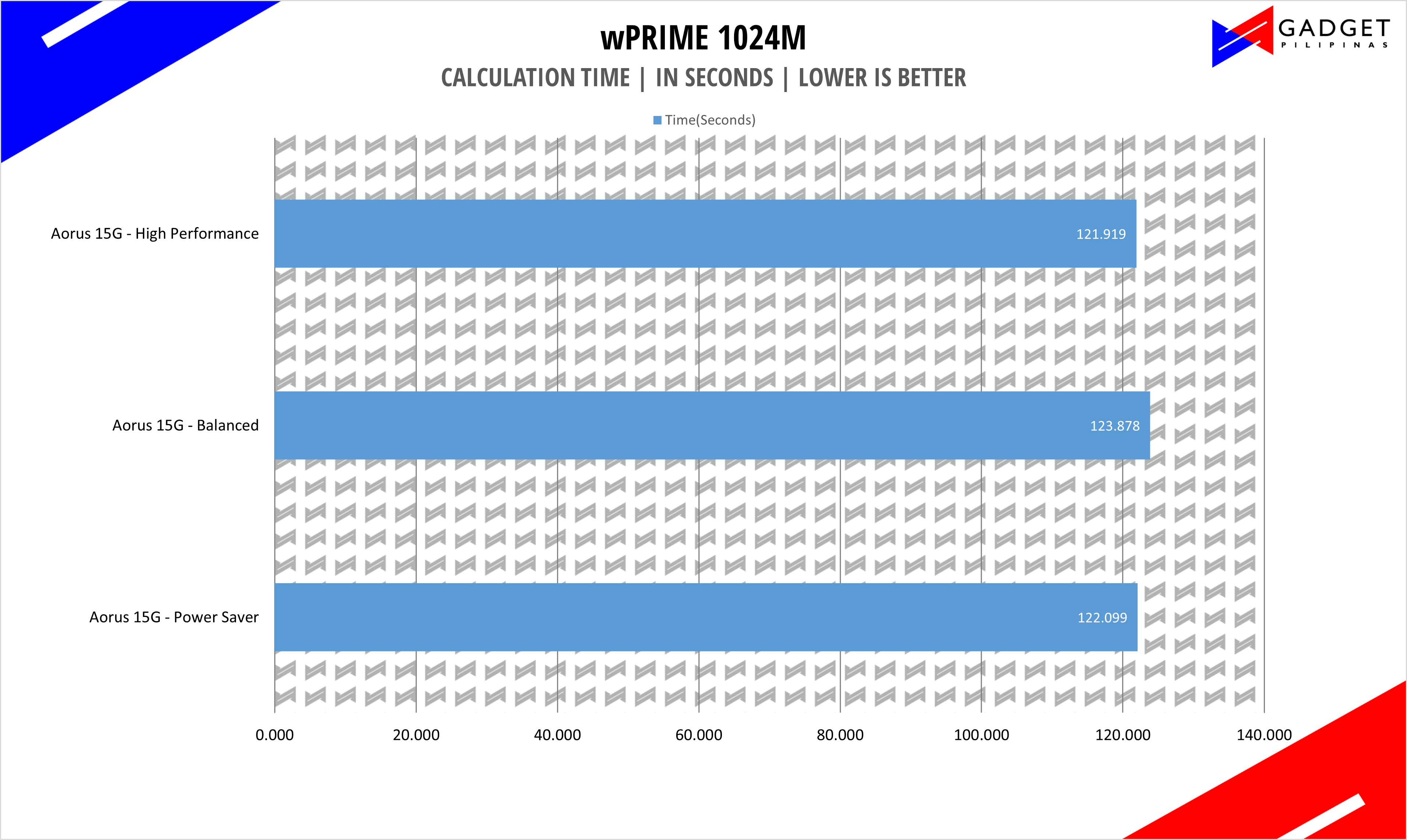 wPrime is a benchmark tool similar to SuperPI, but the former takes on finding prime numbers using Newton’s Method. The benchmark is set to calculate 1024M, and measured according to calculation time.
wPrime is a benchmark tool similar to SuperPI, but the former takes on finding prime numbers using Newton’s Method. The benchmark is set to calculate 1024M, and measured according to calculation time.
GeekBench 5
 Geekbench is a multi-platform benchmark that’s used to gauge CPU performance and compare them across Windows, Mac, and Mobile. Geekbench 5 is the latest version and doesn’t rely on memory as much compared to the previous Geekbench 4, making it a great tool to measure both single-core and multi-core CPU performance.
Geekbench is a multi-platform benchmark that’s used to gauge CPU performance and compare them across Windows, Mac, and Mobile. Geekbench 5 is the latest version and doesn’t rely on memory as much compared to the previous Geekbench 4, making it a great tool to measure both single-core and multi-core CPU performance.
CINEBENCH R20
 Maxon’s Cinebench benchmark is one of the most iconic benchmark applications used by reviewers and enthusiasts. The latest Cinebench R20 uses the latest rendering architectures, including Intel’s Embree ray tracing technology and other advanced features from AMD and Intel that allows users to render the same scene on the same hard. Cinebench R20 uses a larger and more complex testing scene than Cinebench R20 by about 8x computational power and requires 4x the memory.
Maxon’s Cinebench benchmark is one of the most iconic benchmark applications used by reviewers and enthusiasts. The latest Cinebench R20 uses the latest rendering architectures, including Intel’s Embree ray tracing technology and other advanced features from AMD and Intel that allows users to render the same scene on the same hard. Cinebench R20 uses a larger and more complex testing scene than Cinebench R20 by about 8x computational power and requires 4x the memory.
V-RAY
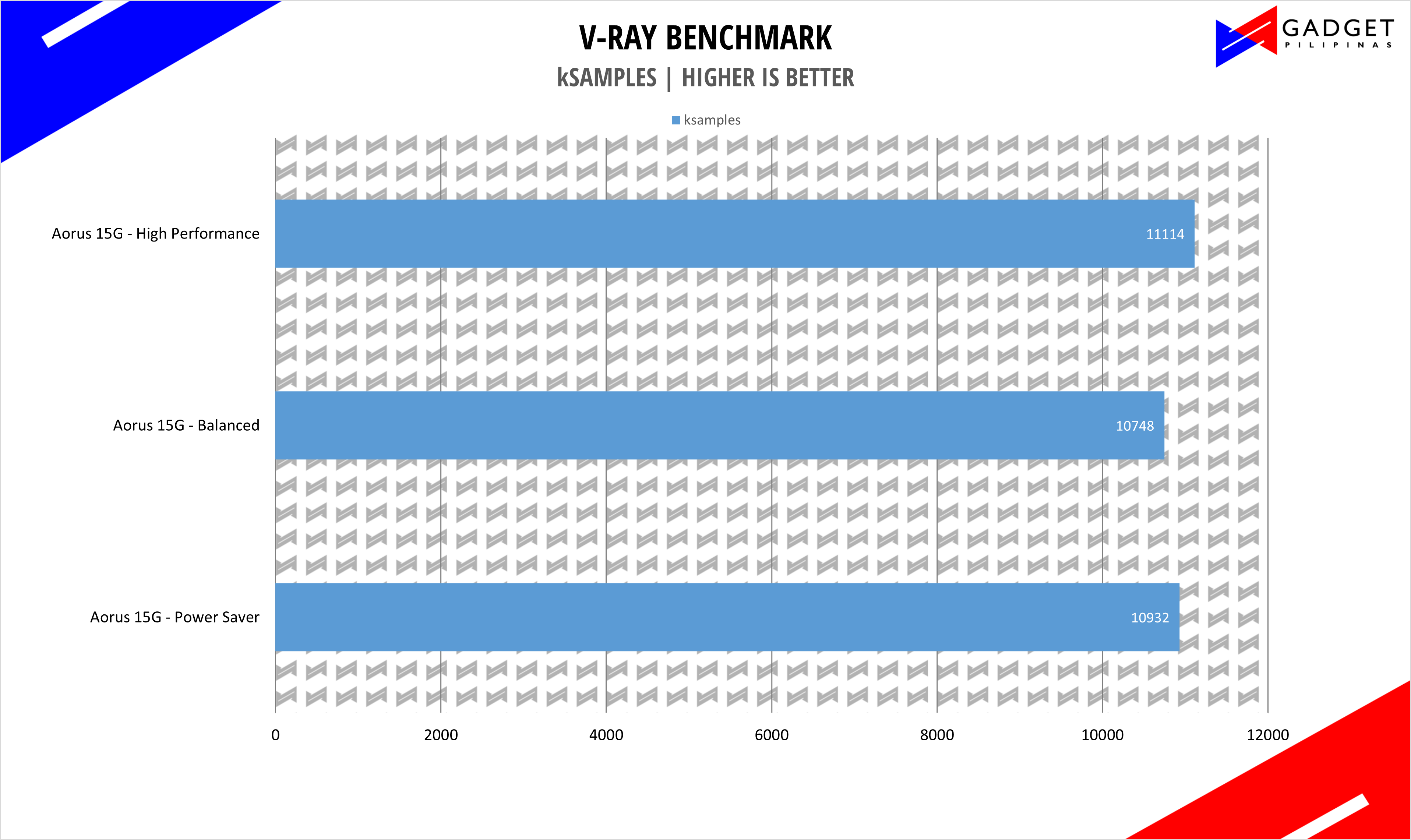 V-Ray Benchmark is a stand-alone version of V-Ray developed by Chaos Group. It is designed to test the CPU and GPU by rendering sample scenes at a fixed amount of time. V-Ray is a plug-in mostly utilized by 3D computer graphics software applications mainly for industrial design, product design, architecture, film, and video game production. V-Ray is not limited to 64-threads as it supports multi and mega threading.
V-Ray Benchmark is a stand-alone version of V-Ray developed by Chaos Group. It is designed to test the CPU and GPU by rendering sample scenes at a fixed amount of time. V-Ray is a plug-in mostly utilized by 3D computer graphics software applications mainly for industrial design, product design, architecture, film, and video game production. V-Ray is not limited to 64-threads as it supports multi and mega threading.
BLENDER
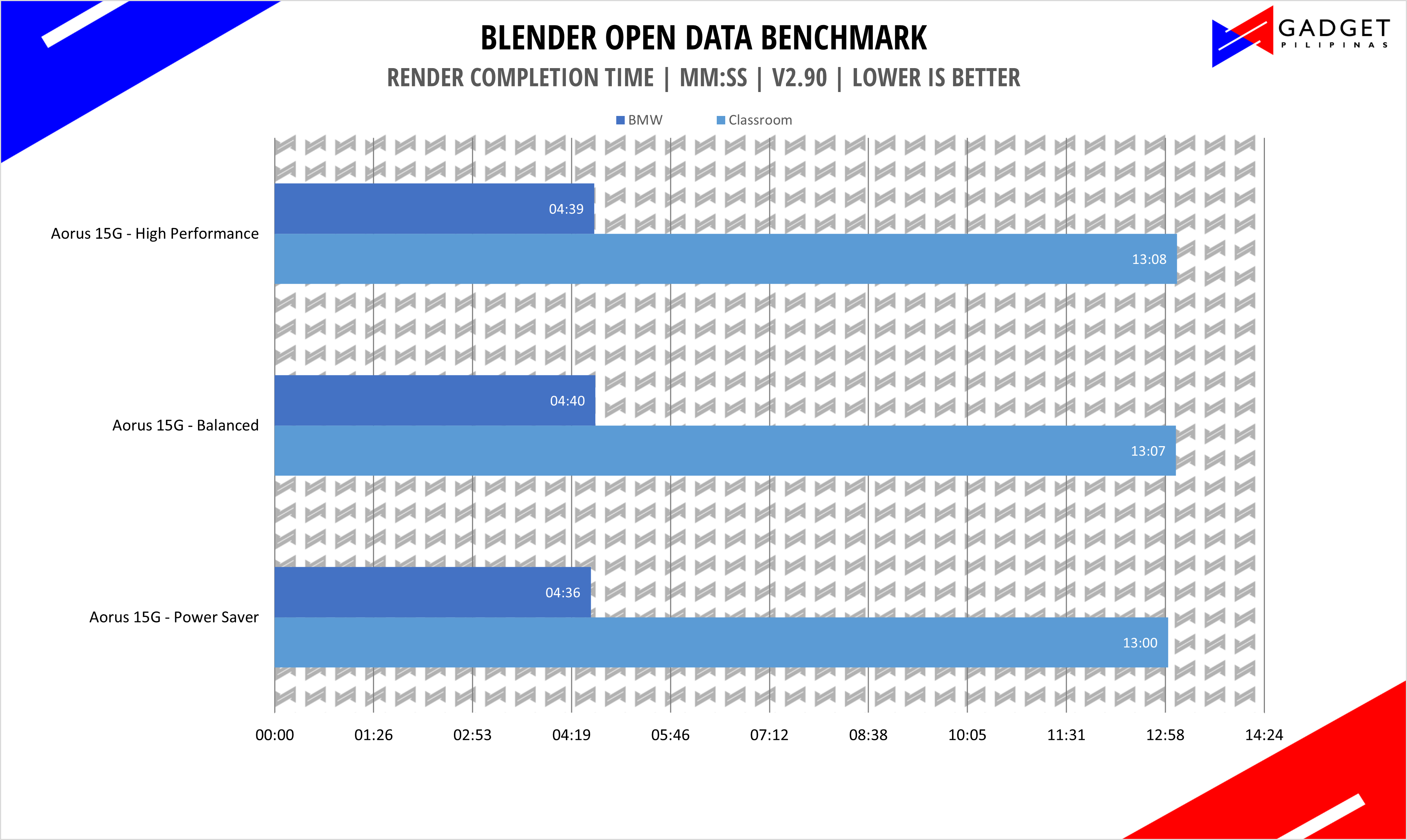 Blender is a widely used, free, open-source 3D creation suite. It supports the whole 3D pipeline process from modeling, rigging, animation, simulation, rendering, and even motion tracking. Blender has become a standard for CPU benchmarks with the BMW27 and Classroom scene most used. This prompted the company to release Blender Open Data Benchmark in 2018, a benchmark-specific version that allows users to run a preset benchmark and share the results online similar to 3D Mark.
Blender is a widely used, free, open-source 3D creation suite. It supports the whole 3D pipeline process from modeling, rigging, animation, simulation, rendering, and even motion tracking. Blender has become a standard for CPU benchmarks with the BMW27 and Classroom scene most used. This prompted the company to release Blender Open Data Benchmark in 2018, a benchmark-specific version that allows users to run a preset benchmark and share the results online similar to 3D Mark.
CORONA RENDERER
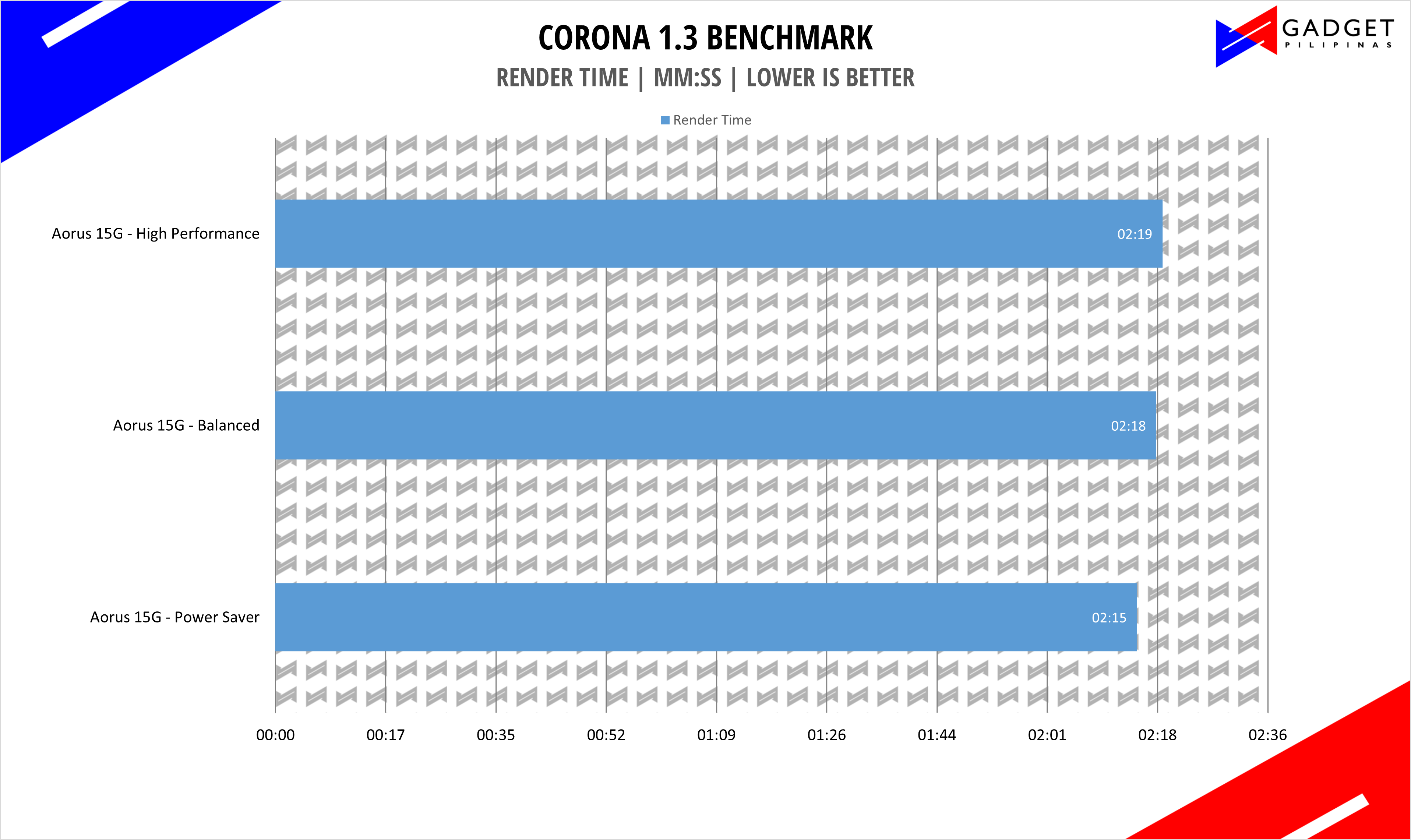 Corona Renderer is an unbiased photorealistic render available for Autodesk 3Ds Max, Maxon Cinema 4D, and as a stand-alone application. Its popularity, similar to Blender, led Chaos Group to develop a benchmark version of the app which runs using Corona Renderer 1.3. Workstation systems, especially CPUs, can utilize Corona Benchmark as up to 72 threads can be used in the benchmark, making it very suitable for CPUs with various price segments.
Corona Renderer is an unbiased photorealistic render available for Autodesk 3Ds Max, Maxon Cinema 4D, and as a stand-alone application. Its popularity, similar to Blender, led Chaos Group to develop a benchmark version of the app which runs using Corona Renderer 1.3. Workstation systems, especially CPUs, can utilize Corona Benchmark as up to 72 threads can be used in the benchmark, making it very suitable for CPUs with various price segments.
SSD Benchmark
- Aorus 15G XC RTX 3070 Review CDM 1GB
- Aorus 15G XC RTX 3070 Review CDM 1GB
- Aorus 15G XC RTX 3070 Review CDM 16GB
- Aorus 15G XC RTX 3070 Review CDM 16GB
Developed by Noriyuki Miyazaki, CrytalDiskMark is a free benchmark tool that is being used by thousands of experts. This tool measures SSD’s sequential read and writes speeds. That means how fast files can be read from and written to the drive, usually measured in MB/s.
The Aorus 15G is equipped with an ESR512GTLCG-EAC-4 512GB NVMe SSD, the same SSD found on other Gigabyte Aero and Aorus Gaming laptops. Our benchmarks show a read and write speed of around 2,800MB/s and 2,500MB/s. Although it’s not the fastest SSD for laptops, it way faster than what other gaming laptops have. Frankly, it’s the 512GB capacity that holds the SSD back, not its speeds.
Gaming Benchmarks
We use CapFrameX Capture and Analysis Tool v1.5.7 to capture framerates for our benchmark run. We are using the latest Nvidia Game Ready 461.23 driver for our benchmarks of the Aorus 15G. HWMonitor and HWInfo64 are both used to measure CPU and GPU temperatures.
3DMARK
- Aorus 15G XC Review 3DMark Firestrike Benchmark
- Aorus 15G XC Review 3DMark Firestrike Benchmark
- Aorus 15G XC Review 3DMark Port Royal Benchmark
- Aorus 15G XC Review 3DMark Port Royal Benchmark
- Aorus 15G XC Review 3DMark TimeSpy Benchmark
- Aorus 15G XC Review 3DMark TimeSpy Benchmark
3DMark is the go-to benchmark for gamers because of the ability to share and compare results online
DOTA 2
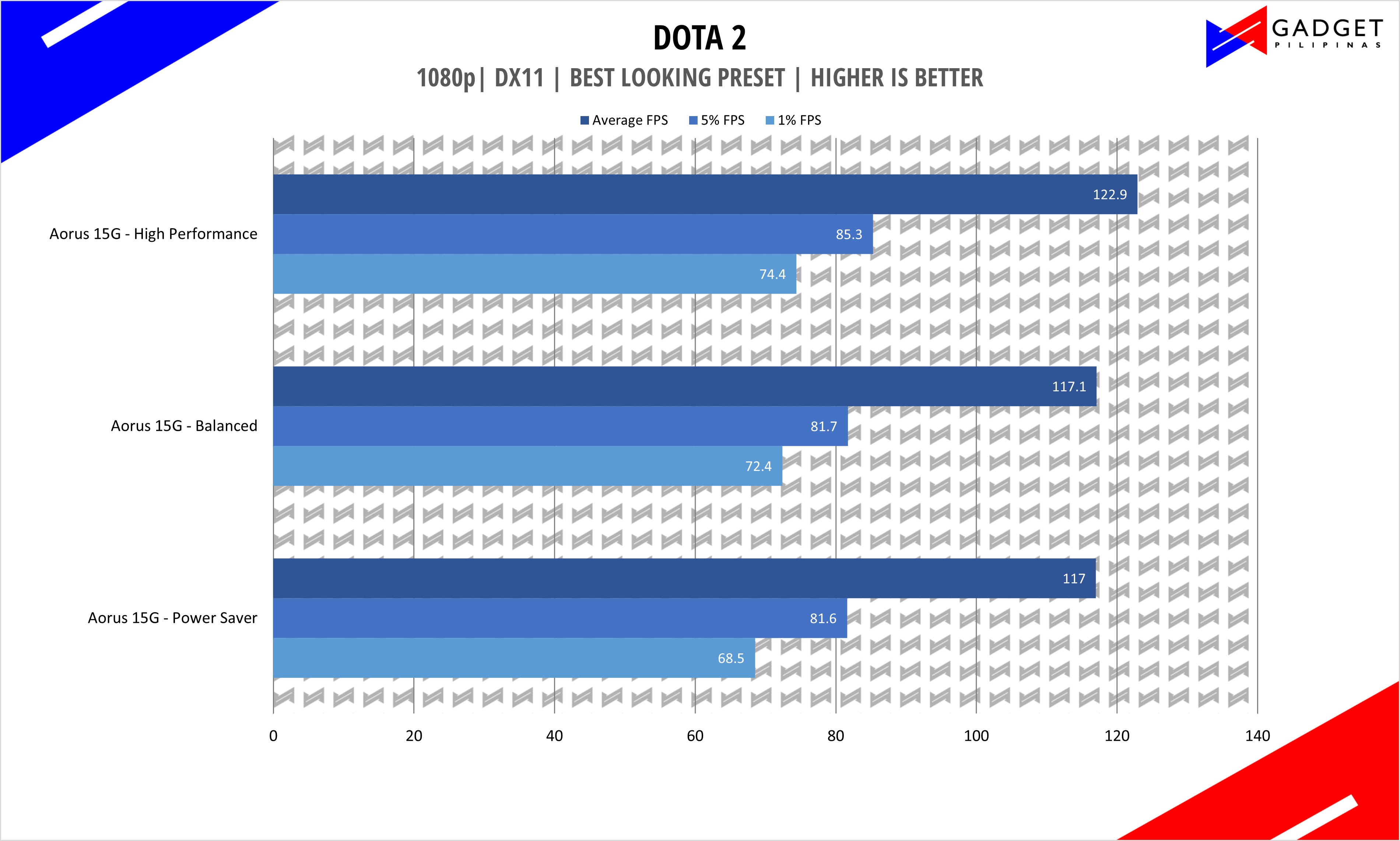 Most gamers play at least one of the following free-to-play titles: League of Legends, CS: GO, Dota 2, and/or Fortnite. Dota 2 is a good representation of the F2P titles as it is the most demanding game in the spectrum. The benchmark will give you an idea of the laptop’s relative performance on other lesser demanding titles. Our benchmark sequence is based on a replay of OG vs. Liquid in the TI9 grand finals from the team fight that happened on 28:30 to 29:30.
Most gamers play at least one of the following free-to-play titles: League of Legends, CS: GO, Dota 2, and/or Fortnite. Dota 2 is a good representation of the F2P titles as it is the most demanding game in the spectrum. The benchmark will give you an idea of the laptop’s relative performance on other lesser demanding titles. Our benchmark sequence is based on a replay of OG vs. Liquid in the TI9 grand finals from the team fight that happened on 28:30 to 29:30.
Far Cry 5
 Far Cry 5 is an FPS game published by Ubisoft and uses the Dunia engine. It heavily relies on and takes advantage of DirectX 11 to render a realistic environment that makes it taxing to both the CPU and GPU.
Far Cry 5 is an FPS game published by Ubisoft and uses the Dunia engine. It heavily relies on and takes advantage of DirectX 11 to render a realistic environment that makes it taxing to both the CPU and GPU.
Rainbow Six Siege
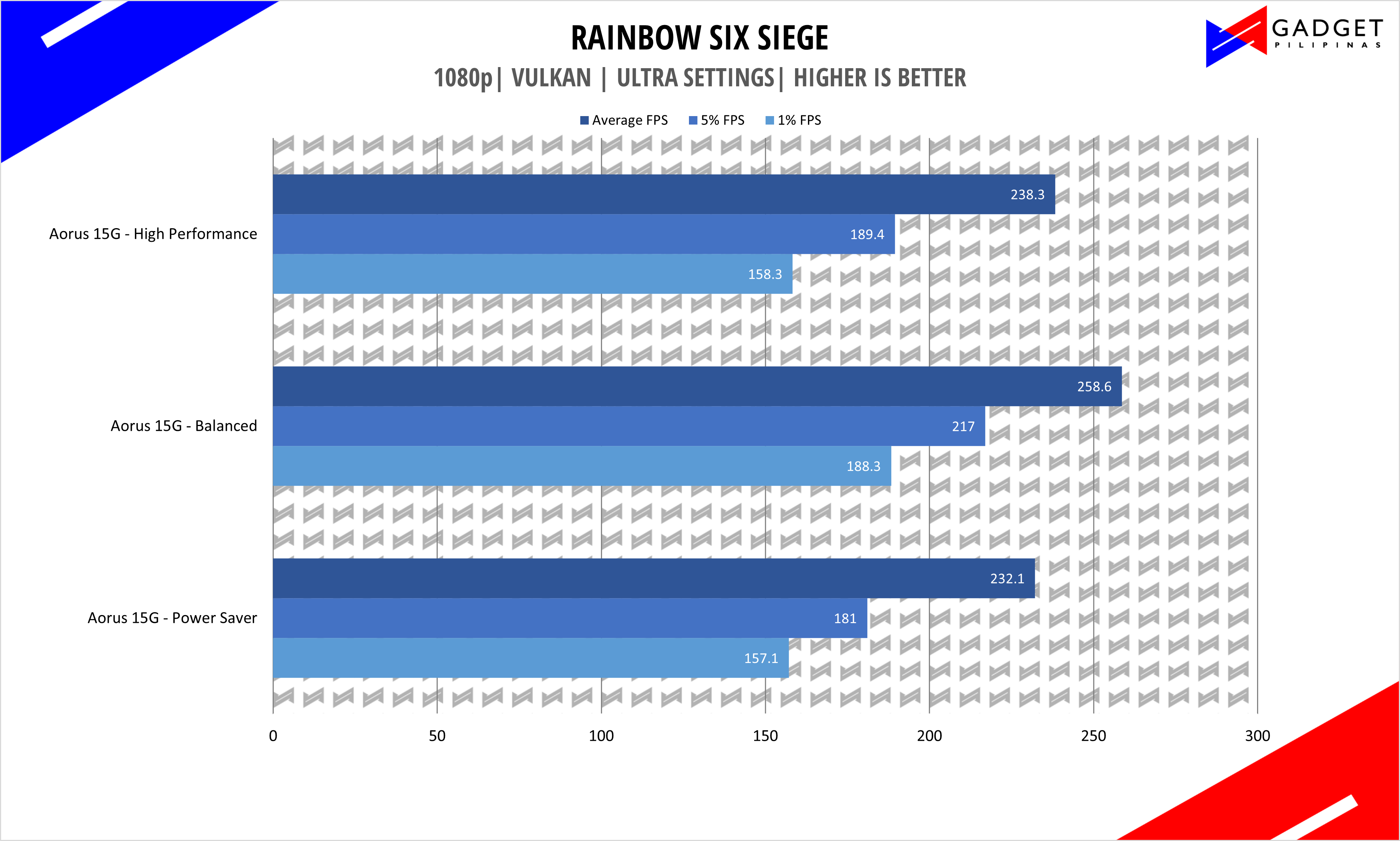 Rainbow Six Seige is one of the few popular AAA games that’s still popular in 2021 due to its competitive gameplay mechanics. R6S uses the AnvilNext game engine, which is developed by the game’s publisher, Ubisoft. As of writing, Rainbow Six Siege is currently the most popular Tom Clancy title beating out Wildlands, Breakpoint and even, Division 2. Rainbow Six Seige is one of the few popular AAA games that’s still popular in 2019 due to its competitive gameplay mechanics. R6S uses the AnvilNext game engine, which is developed by the game’s publisher, Ubisoft. As of writing, Rainbow Six Siege is currently the most popular Tom Clancy title beating out Wildlands, Breakpoint and even, Division 2.
Rainbow Six Seige is one of the few popular AAA games that’s still popular in 2021 due to its competitive gameplay mechanics. R6S uses the AnvilNext game engine, which is developed by the game’s publisher, Ubisoft. As of writing, Rainbow Six Siege is currently the most popular Tom Clancy title beating out Wildlands, Breakpoint and even, Division 2. Rainbow Six Seige is one of the few popular AAA games that’s still popular in 2019 due to its competitive gameplay mechanics. R6S uses the AnvilNext game engine, which is developed by the game’s publisher, Ubisoft. As of writing, Rainbow Six Siege is currently the most popular Tom Clancy title beating out Wildlands, Breakpoint and even, Division 2.
Shadow of The Tomb Raider
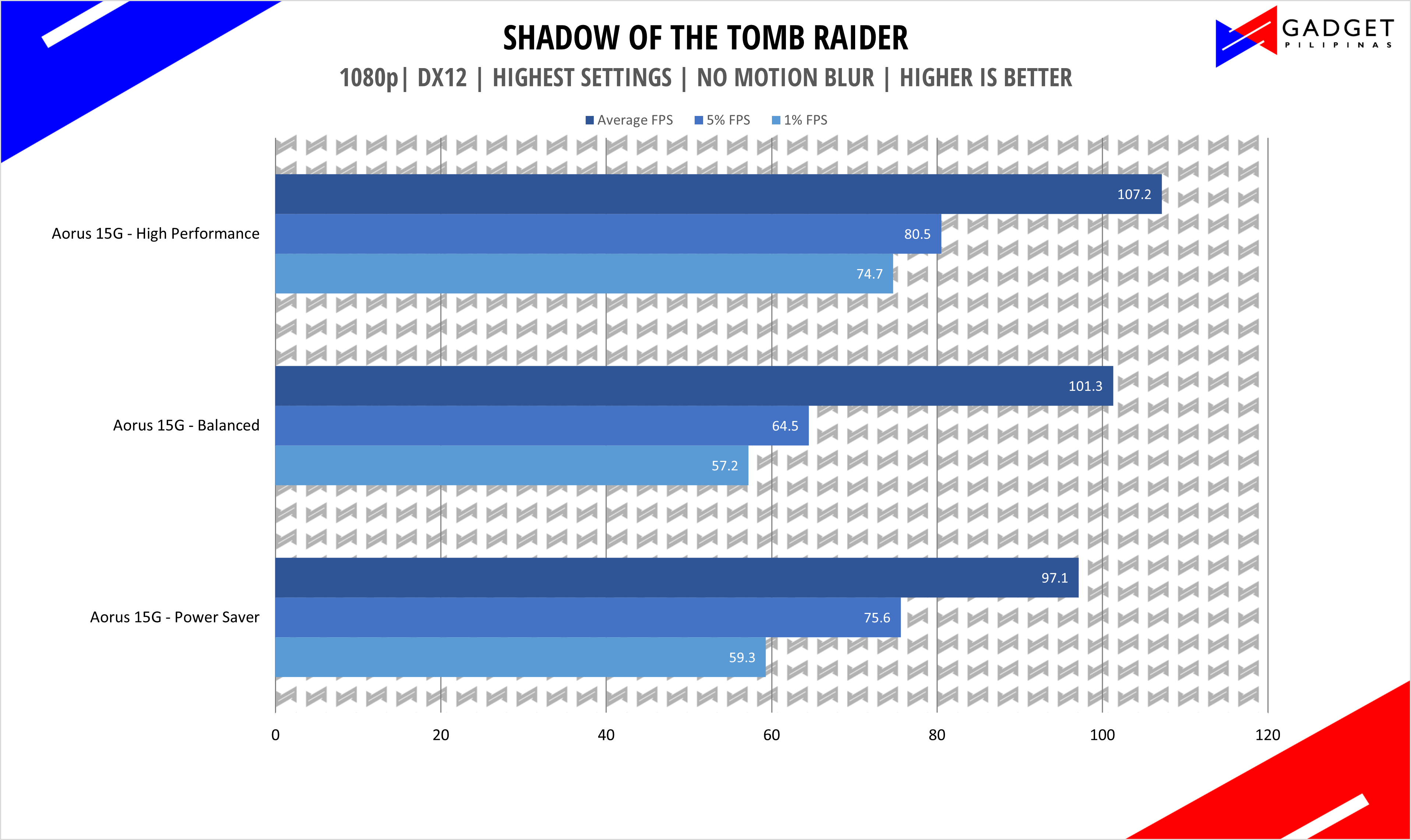 Shadow of The Tomb Raider or SOTR is the latest installment of the Lara Croft Tomb Raider franchise. Developed by Square Enix, SOTR uses the Foundation engine and is further enhanced by Eidos Montreal. STOR is also one of the first games to come out with Ray Tracing and DLSS support.
Shadow of The Tomb Raider or SOTR is the latest installment of the Lara Croft Tomb Raider franchise. Developed by Square Enix, SOTR uses the Foundation engine and is further enhanced by Eidos Montreal. STOR is also one of the first games to come out with Ray Tracing and DLSS support.
F1 2020
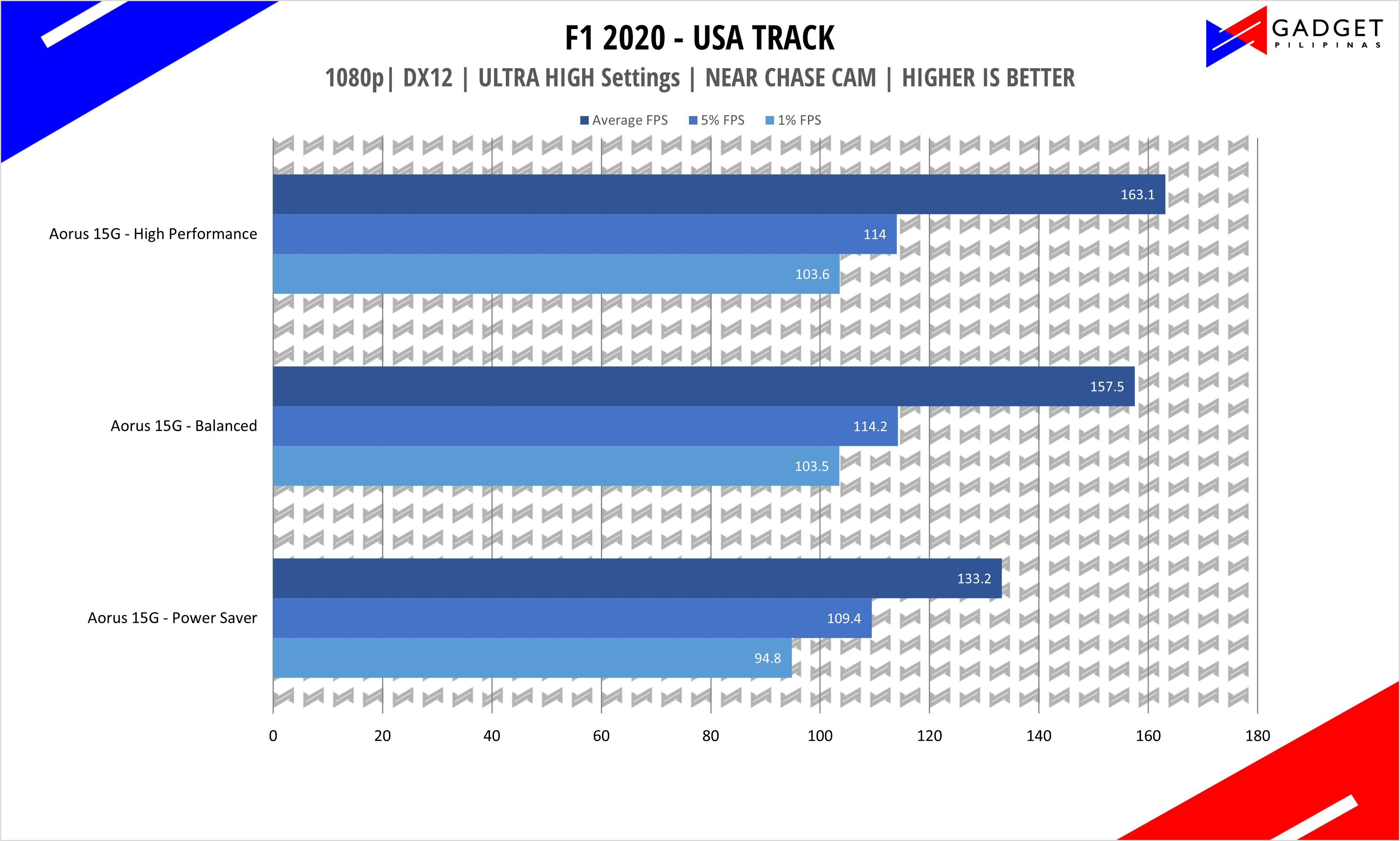 F1 2020 is the official video game of the 2020 Formula 1 and Formula 2 championships developed by Codemasters. F1 2020 is the twelfth installment in the franchise and uses the Ego Engine 3.0. F1 2020 is a good representation of racing games thanks to its realistic graphics and fairly demanding spec requirements.
F1 2020 is the official video game of the 2020 Formula 1 and Formula 2 championships developed by Codemasters. F1 2020 is the twelfth installment in the franchise and uses the Ego Engine 3.0. F1 2020 is a good representation of racing games thanks to its realistic graphics and fairly demanding spec requirements.
Assassin’s Creed: Odyssey
 Assassin’s Creed Odyssey is the latest franchise installment from Ubisoft. It’s by far the most popular and stable Assassin’s Creed title since AC IV: Black Flag. It uses the AnvilNext 2.0 game engine, an updated version of Rainbow Six Siege’s game engine, and uses the DirectX 12 API.
Assassin’s Creed Odyssey is the latest franchise installment from Ubisoft. It’s by far the most popular and stable Assassin’s Creed title since AC IV: Black Flag. It uses the AnvilNext 2.0 game engine, an updated version of Rainbow Six Siege’s game engine, and uses the DirectX 12 API.
Cyberpunk 2077
Cyberpunk 2077 is arguably the most hyped game of 2020. Developed by CD Projekt Red, the dystopian open-world, action-adventure RPG sports is one of the most demanding titles to date. Cyberpunk 2077 also supports three Ray Tracing settings as well as DLSS which makes the game a great tool to measure Ray tracing performance for both AMD and Nvidia graphics cards.
Horizon Zero Dawn
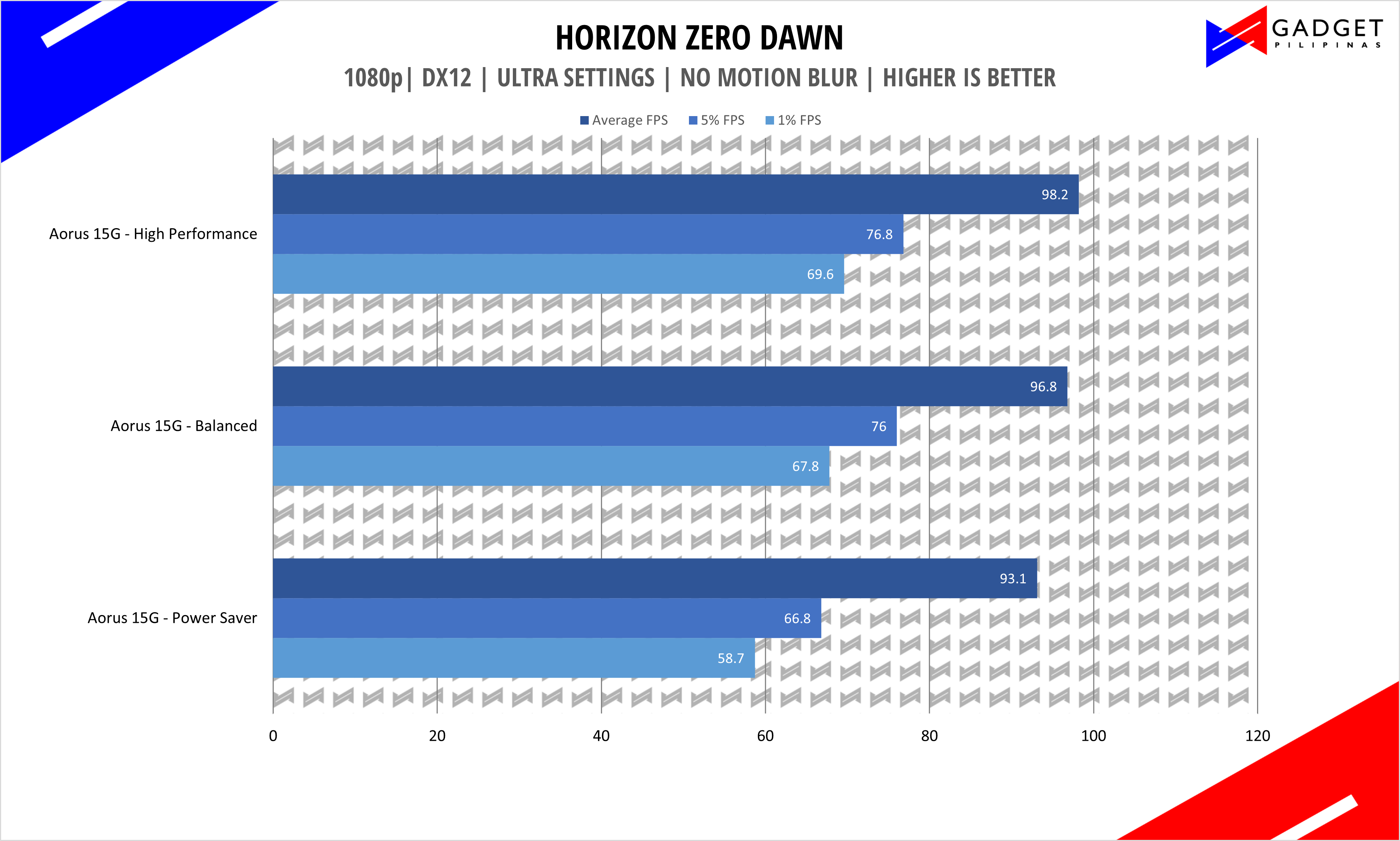 Horizon Zero Dawn is one of the most popular console-port RPG developed by Guerilla Games and published by Sony Interactive Entertainment. Horizon Zero Dawn is a multi-award-winning action RPG and its popularity resulted in an exclusive Complete Edition game bundle in Steam.
Horizon Zero Dawn is one of the most popular console-port RPG developed by Guerilla Games and published by Sony Interactive Entertainment. Horizon Zero Dawn is a multi-award-winning action RPG and its popularity resulted in an exclusive Complete Edition game bundle in Steam.
Noise and Acoustics
 Weirdly enough, Aorus 15G XC’s Balanced mold has the most quiet fan noise at only 53.6 decibels. Frankly, the 2-decibel delta isn’t that noticeable especially when you’re immersed in gaming.
Weirdly enough, Aorus 15G XC’s Balanced mold has the most quiet fan noise at only 53.6 decibels. Frankly, the 2-decibel delta isn’t that noticeable especially when you’re immersed in gaming.
Battery Life and Thermals
Despite the improved efficiency of the latest RTX 30 series mobile graphics card, our battery life benchmark still shows the average 4-6 hour range of a typical gaming laptop. Switching from high performance to power saver profile extends the Aorus 15G XC’s battery life from 4 hours to 6 hours.
- Aorus 15G XC Review 10870H CPU Temps
- Aorus 15G XC Review 10870H CPU Temps
- Aorus 15G XC Review RTX 3070 GPU Temps
- Aorus 15G XC Review RTX 3070 GPU Temps
Aorus’ Windforce Infinity Cooling System on the Aorus 15G XC seems to be mediocre as the Intel Core i7 10870H peaks at 97°c with the 80-watt RTX 3070 maxing out at 83°c. However, the temperature improvements on balanced mode show that a simple fan curve tuning via the Aorus Control Center software could improve the Aorus 15G XC’s temperatures.
Despite the concerning CPU and GPU temperatures, surface temps aren’t a problem as we were only able to record a peak WASD area temperature of 31.7°c using our infrared thermometer. This means you won’t be disrupted while playing on the Aorus 15G XC.
Conclusion
True to its marketing spiel, the Aorus 15G XC offers great mobility with its 23mm thickness and 2kilogram weight without having to sacrifice raw performance numbers. That said, my time with the Aorus 15G XC is a love-hate relationship on how well it does for a portable machine but the lackluster performance when it comes to pure gaming. Its well-crafted chassis,full-sized keyboard, windows precision trackpad, and 240Hz IPS display make it shine in terms of mobility. However, the poor thermals hold both the Core i7 10870H and RTX 3070 back in getting the highest FPS numbers for this configuration.
Overall, the Aorus 15G is ideal for on-the-go gamers and professionals who require almost no-compromise in portability – you’re sure to get its Php 107,995 price. Users who are looking for a desktop-replacement laptop might want to look elsewhere such as Aorus’ 15P and 17G models.
Grant is a Financial Management graduate from UST. His passion for gadgets and tech crossed him over in the industry where he could apply his knowledge as an enthusiast and in-depth analytic skills as a Finance Major. His passion allows him to earn at the same time help Gadget Pilipinas' readers in making smart, value-based decisions and purchases with his reviews and guides.

